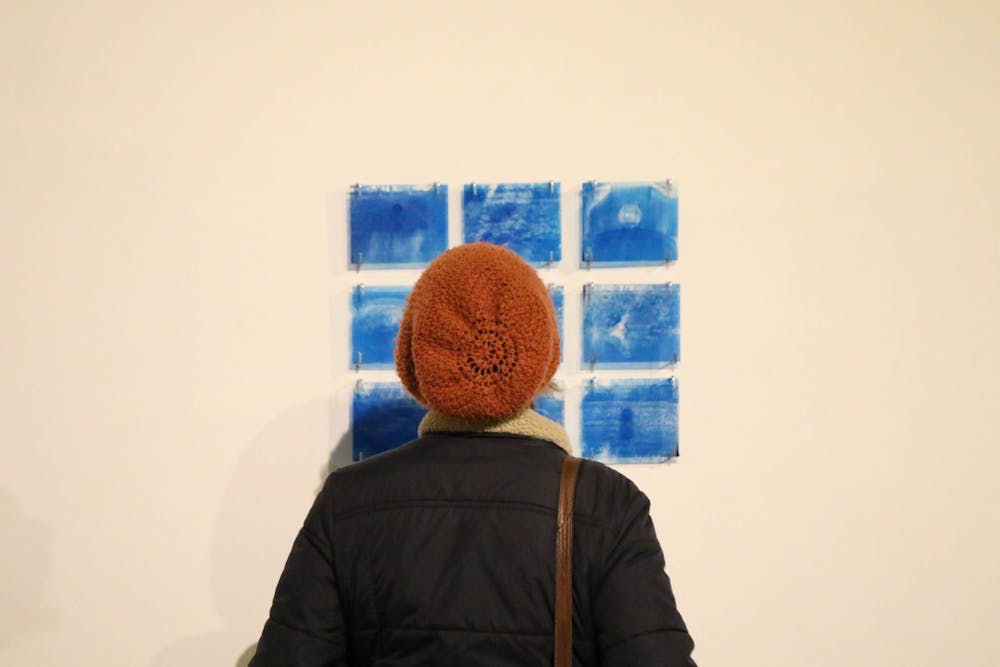Buy the art from the “White River Guide”
The River Guide will be on sale on Goodman and Stacey’s social media, and proceeds will go to Muncie Clean and Beautiful, an organization whose mission is to empower and promote stewardship of clean streets, beautiful neighborhoods and a healthy river.
Visit Makenzie Goodman’s Instagram account, @makenzelyn, for more information.
Source: Makenzie Goodman, PlySpace artist-in-residence and co-creator of the “White River Guide.”
Through the center of downtown Muncie runs the White River, a primary source for drinking water in the community that has both literally and figuratively had its highs and lows. It’s a 13-minute walk from the heart of downtown Muncie to the White River — accessible to everyone and an almost daily sight.
At the end of September, the Muncie Arts and Culture Council collaborated with Ball State’s School of Art to create a “White River Art Guide” that showcases the White River’s past, present and future. The White River runs alongside White River Boulevard and cuts through most of Muncie’s parks, making it a prominent feature in the community.
PlySpace’s artist-in-residence is a program under Muncie Arts and Culture Council located in downtown Muncie that allows artists to pursue projects in the local area. Two artists-in-residence from Texas, Makenzie Goodman and Adam Stacey, partnered with a fall 2021 Ball State 2D Foundations class taught by Devon Ward, assistant teaching professor of graphic design and visual communication, to create the “White River Guide.”
This project lasted five weeks. For the duration of the project, a group of 14 Ball State students — all members of the class — visited the White River to get a firsthand experience of the area.
Goodman, Stacey and the students used multiple art mediums and turned them into a cyanotype map — a photographic printing process that produces a cyan blue print — focusing on the history of the White River.
“Our goals were to create something that could be collaborative and community-based and was also in response to the White River with students,” Stacey said.
The finished piece was a 30-by-36 inch large scale print featuring Goodman, Stacey and the students’ work. Goodman said the piece was challenging, but it was exciting to create the finished project with different perspectives incorporated in one large piece.
“The purpose of this project was to showcase the White River and the history surrounding it,” Goodman said.
While Goodman and Stacey have spent most of their time working together in California and Texas, Goodman said coming to Muncie has been a different experience.
“[Muncie’s] history is just so much older than the history out west,” Goodman said.
In the spring 2021 semester, Ward taught an art class exploring how biodesign — a process of integrating organic materials into the creation of buildings and products — could improve the ecology of the White River, so he already had background knowledge of the river. In Ward’s fall 2021 class, the students started by learning about the history of the White River and its pollution.
“Students love the site visits,” Ward said. “They love the experience outside of the classroom that then can inform their artwork once they're back in the class. And they also like rubbing shoulders with professional artists that are making their work today.”
After learning about some of the history, the students went to the White River in early October to do site-responsive artwork, which included taking photographs and sketching what they saw.
Students were then able to create drawings and photograms — a technique that allows objects to be set on a light-sensitive surface, and then creates a shadow of the object, looking similar to a photo.
“Some students really gravitated toward the rustic sort of steel bridges that was kind of this representation of the industrial Muncie,” Ward said. “And then, others responded to the more natural elements, so they took photographs of the animals there [and] they took photographs of the trees and the plants there.”
After the initial site visits, the students continued to work and go back to the site multiple times to finish their individual parts of the project, which included re-sketching and modifying their work.
The White River project was showcased Nov. 18, 2021 at PlySpace downtown.
“The event was really amazing,” Roland said. “It was great being able to see the work we had created with Adam and Makenzie displayed for more than just our class to see, as well as the other work that they were making while staying at PlySpace.”
Ward said he thinks this project was beneficial for his students because they didn’t have a lot of requirements and just had to create something that tied back to the White River.
“If you have every possibility open, where do you actually turn to, that’s actually a really productive thing, because as artists, when you graduate, no one’s telling you, ‘You have to do this or you have to do that,’” Ward said.
Kendal Roland, freshman art education major who was involved with the River Guide, created negative transparency of photos she took.
“I took items I found from around the White River such as glass, scrap, metal, leaves and branches,” Roland said.
Roland said she has enjoyed being involved in the “White River Guide,” especially because of the networking and teamwork opportunities it gave her.
“From this project, I learned a lot,” Roland said. “I learned what traveling artists do in order to share their work and make a living, explored new creative briefs, worked in a group setting to create [a] collaborative piece for the first time and, overall, found a new passion for turning trash into treasure.”
Contact Krystiana Brosher with comments at krystiana.brosher@bsu.edu or on Twitter @Krystiana_21.





